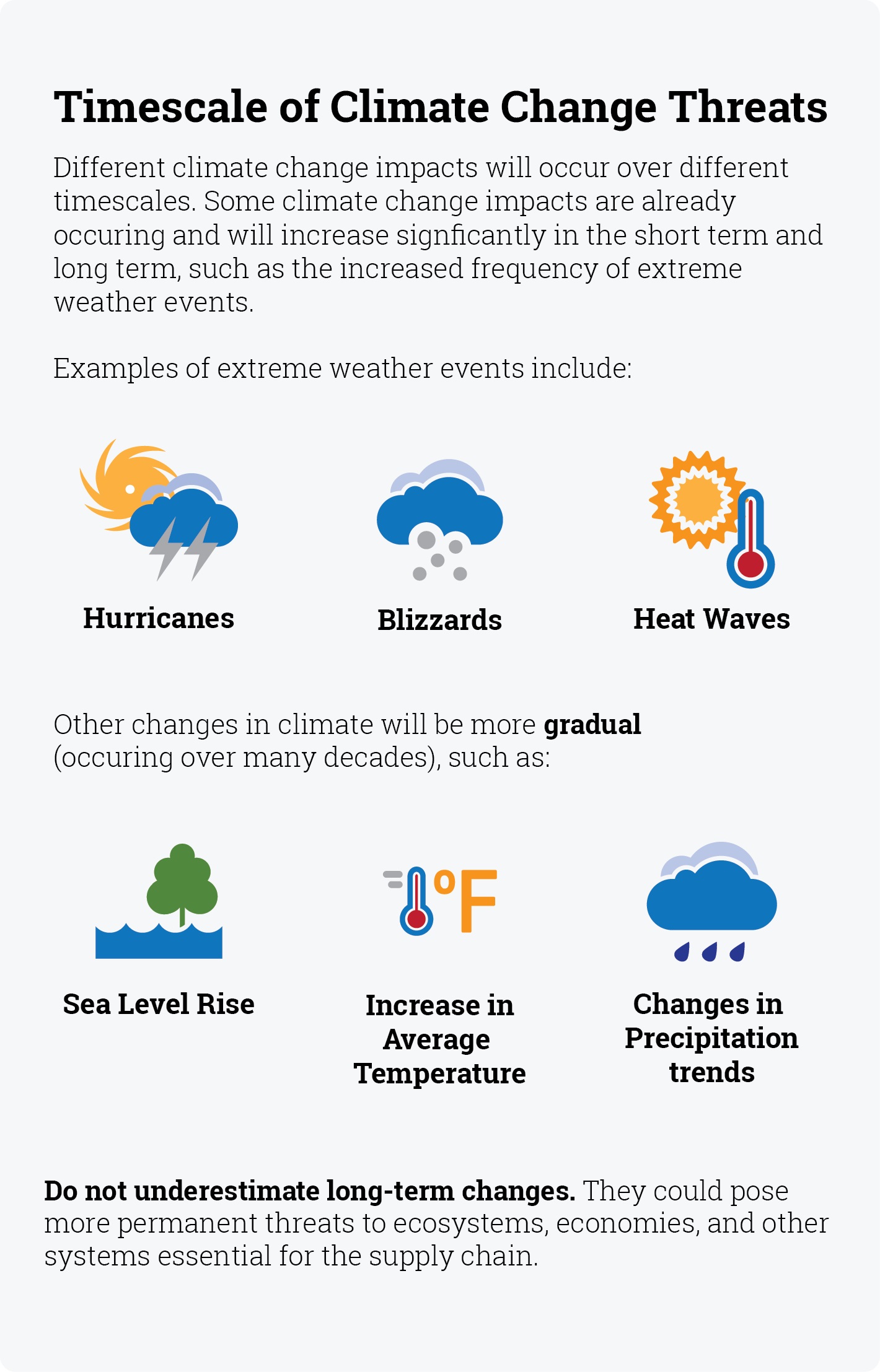Framework Step 1: Identify
What Are the Climate Risks to Critical Supply Chains?
You will need to understand your agency’s procurement methods, the goods and services acquired by the agency and provided either internally or externally of the agency, and as much geographic specificity about the steps in the chain as possible. The better your understanding of the supply chain, the better the risk assessment will be. Contractors and subcontractors may be able to provide additional specifics about each step in the supply chain.
Critical Supply Chains
Identify Critical Supply Chains
| Context |
|---|
| Hundreds, if not thousands, of global supply chains support Federal agencies’ operations on a day-to-day basis. However, not all of these supply chains are vital for agencies to fulfill their core functions. By identifying the critical supply chains, agencies can most effectively prioritize the at-risk supply chains that would result in the most significant consequences if disrupted. Additionally, it is important to notify GSA if your agency purchases critical products and services through GSA channels. Although the core risk-management responsibilities still lie with your agency, there may be opportunities to partner with GSA to address vulnerabilities. |
In order to manage risk, a first step is to identify the risks. The primary elements of identifying climate risks to supply chains are:
- Identify critical supply chains
- Identify the climate-sensitive elements of supply chains
- Identify key climate threats
Some Federal agencies have already identified critical supply chains. If your agency has already identified which supply chains are critical, move on to identifying the climate-sensitive elements of the supply chain.
If your agency has not identified critical supply chains, some factors to consider include:
- What are the critical services provided by your agency?
- What supply chain(s) support these critical services?
- What historical disruptions have had the greatest impact on the agency’s ability to fulfill critical services? Your agency’s Office of Mission Assurance or continuity of operations planners may be good source of this information.
- What disrupted supply chain(s) most impacted your agency’s mission?
- Which goods and services are most time-sensitive for delivery?
- Which goods and services require the most significant investment of time and resources by the agency, its contractors, and subcontractors to acquire?
- What are your agency’s top budgetary "spend" areas?
- Which contracts (and contractors) support these spend areas?
Only critical supply chains need to be advanced through the rest of this process.
Map Out Critical Supply Chains
Map out, through maps, flow charts, or other forms, the steps between raw materials and product or service delivery for the critical supply chain to the extent possible. Also determine where, geographically, each link in the supply chain resides, if possible, using online mapping applications. Supplier/contractor addresses in the Federal Procurement Data System can provide some key locations in which supply chains exist. Identify the locations on which the supply chain is reliant, such as important ports of entry, production facilities, or key transportation routes. If needed, engage contractors or external consultants to assist with this process.
Climate-Sensitive Elements of Supply Chains
Identify the Climate-Sensitive Elements of the Supply Chain
| Context |
|---|
| The goal at this stage is to determine what type of climate information to collect. There is an opportunity later in this framework to assess in more detail how sensitive the supply chain is to particular climate threats. |
| Additional Information |
| GSA’s Professional Services Schedule, 00CORP, contains Category 899 1, Environmental Consulting Services |
Consider what elements of the supply chain are sensitive to climate by answering these broad yes/no questions:
- Does weather (e.g., temperature, rainfall or drought, snow, hurricanes, coastal flooding) directly influence any step in the supply chain (e.g., consider if any raw materials are agricultural commodities)?
- Are the raw materials in the supply chain sensitive to changes in climate or extreme weather?
- Are the raw materials in the supply chain in geographic locations that are highly sensitive to climate or weather?
- Are the modes of transportation used likely to be affected by climate or extreme weather (e.g., does the supply chain depend on seasonal ice roads)?
- Is delivery of goods or services likely to be affected by weather?
- Does the timing or availability of any materials depend on weather (e.g., temperature, rainfall, snow)?
- Is the supply chain sourcing, inputs, and transportation flexible to accommodate disruptions?
- Can materials be sourced from other locations or use different delivery modes? The less flexible it is, the more likely it is to be sensitive to climate risk.
Based on the responses to these questions, determine if the critical supply chain is sensitive to weather and climate.
Key Climate Threats
Identify Key Climate Threats
Determine which climate threats could affect the critical supply chain and should be considered in more depth.
Identify climate threats that (1) are geographically relevant (i.e., could occur at any point along the supply chain); and (2) could affect the supply chain elements or activities. Also consider the timing of expected changes to climate. Many contracts only extend a few years, so increases in the frequency and severity of extreme weather events might be more pressing than gradual changes in temperature over many years.
Information collected in this step will be informative for the following sections when identifying the likelihood and magnitude of consequences of climate threats. It may be beneficial to bring in an external consultant to assist with identifying and processing the climate information.
Examples of the kinds of climate threats that can affect supply chains are:
- Extreme heat waves
- Changes in temperature (e.g., affecting growing seasons, freeze/thaw cycles, plant hardiness zones)
- Extreme precipitation events (and resultant flooding, erosion, landslides, and/or sedimentation)
- Sea level rise
- Tropical storms and hurricanes
- Drought
- Wildfires
- Heavy winds (e.g., gust strength, duration of sustained winds, frequency of wind events)
- Humidity
- Winter Weather
Content developed by the the Office of Acquisition Management, Federal Acquisition Service, General Services Administration.


